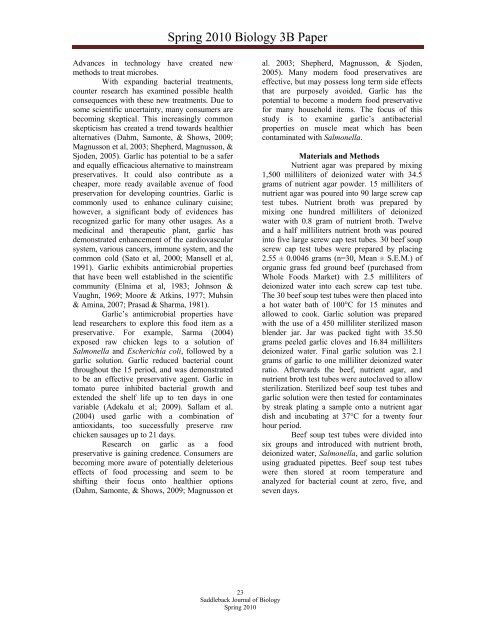Saddleback Journal of Biology - Saddleback College
Saddleback Journal of Biology - Saddleback College
Saddleback Journal of Biology - Saddleback College
You also want an ePaper? Increase the reach of your titles
YUMPU automatically turns print PDFs into web optimized ePapers that Google loves.
Spring 2010 <strong>Biology</strong> 3B Paper<br />
Advances in technology have created new<br />
methods to treat microbes.<br />
With expanding bacterial treatments,<br />
counter research has examined possible health<br />
consequences with these new treatments. Due to<br />
some scientific uncertainty, many consumers are<br />
becoming skeptical. This increasingly common<br />
skepticism has created a trend towards healthier<br />
alternatives (Dahm, Samonte, & Shows, 2009;<br />
Magnusson et al, 2003; Shepherd, Magnusson, &<br />
Sjoden, 2005). Garlic has potential to be a safer<br />
and equally efficacious alternative to mainstream<br />
preservatives. It could also contribute as a<br />
cheaper, more ready available avenue <strong>of</strong> food<br />
preservation for developing countries. Garlic is<br />
commonly used to enhance culinary cuisine;<br />
however, a significant body <strong>of</strong> evidences has<br />
recognized garlic for many other usages. As a<br />
medicinal and therapeutic plant, garlic has<br />
demonstrated enhancement <strong>of</strong> the cardiovascular<br />
system, various cancers, immune system, and the<br />
common cold (Sato et al, 2000; Mansell et al,<br />
1991). Garlic exhibits antimicrobial properties<br />
that have been well established in the scientific<br />
community (Elnima et al, 1983; Johnson &<br />
Vaughn, 1969; Moore & Atkins, 1977; Muhsin<br />
& Amina, 2007; Prasad & Sharma, 1981).<br />
Garlic’s antimicrobial properties have<br />
lead researchers to explore this food item as a<br />
preservative. For example, Sarma (2004)<br />
exposed raw chicken legs to a solution <strong>of</strong><br />
Salmonella and Escherichia coli, followed by a<br />
garlic solution. Garlic reduced bacterial count<br />
throughout the 15 period, and was demonstrated<br />
to be an effective preservative agent. Garlic in<br />
tomato puree inhibited bacterial growth and<br />
extended the shelf life up to ten days in one<br />
variable (Adekalu et al; 2009). Sallam et al.<br />
(2004) used garlic with a combination <strong>of</strong><br />
antioxidants, too successfully preserve raw<br />
chicken sausages up to 21 days.<br />
Research on garlic as a food<br />
preservative is gaining credence. Consumers are<br />
becoming more aware <strong>of</strong> potentially deleterious<br />
effects <strong>of</strong> food processing and seem to be<br />
shifting their focus onto healthier options<br />
(Dahm, Samonte, & Shows, 2009; Magnusson et<br />
al. 2003; Shepherd, Magnusson, & Sjoden,<br />
2005). Many modern food preservatives are<br />
effective, but may possess long term side effects<br />
that are purposely avoided. Garlic has the<br />
potential to become a modern food preservative<br />
for many household items. The focus <strong>of</strong> this<br />
study is to examine garlic’s antibacterial<br />
properties on muscle meat which has been<br />
contaminated with Salmonella.<br />
Materials and Methods<br />
Nutrient agar was prepared by mixing<br />
1,500 milliliters <strong>of</strong> deionized water with 34.5<br />
grams <strong>of</strong> nutrient agar powder. 15 milliliters <strong>of</strong><br />
nutrient agar was poured into 90 large screw cap<br />
test tubes. Nutrient broth was prepared by<br />
mixing one hundred milliliters <strong>of</strong> deionized<br />
water with 0.8 gram <strong>of</strong> nutrient broth. Twelve<br />
and a half milliliters nutrient broth was poured<br />
into five large screw cap test tubes. 30 beef soup<br />
screw cap test tubes were prepared by placing<br />
2.55 ± 0.0046 grams (n=30, Mean ± S.E.M.) <strong>of</strong><br />
organic grass fed ground beef (purchased from<br />
Whole Foods Market) with 2.5 milliliters <strong>of</strong><br />
deionized water into each screw cap test tube.<br />
The 30 beef soup test tubes were then placed into<br />
a hot water bath <strong>of</strong> 100°C for 15 minutes and<br />
allowed to cook. Garlic solution was prepared<br />
with the use <strong>of</strong> a 450 milliliter sterilized mason<br />
blender jar. Jar was packed tight with 35.50<br />
grams peeled garlic cloves and 16.84 milliliters<br />
deionized water. Final garlic solution was 2.1<br />
grams <strong>of</strong> garlic to one milliliter deionized water<br />
ratio. Afterwards the beef, nutrient agar, and<br />
nutrient broth test tubes were autoclaved to allow<br />
sterilization. Sterilized beef soup test tubes and<br />
garlic solution were then tested for contaminates<br />
by streak plating a sample onto a nutrient agar<br />
dish and incubating at 37°C for a twenty four<br />
hour period.<br />
Beef soup test tubes were divided into<br />
six groups and introduced with nutrient broth,<br />
deionized water, Salmonella, and garlic solution<br />
using graduated pipettes. Beef soup test tubes<br />
were then stored at room temperature and<br />
analyzed for bacterial count at zero, five, and<br />
seven days.<br />
23<br />
<strong>Saddleback</strong> <strong>Journal</strong> <strong>of</strong> <strong>Biology</strong><br />
Spring 2010

















